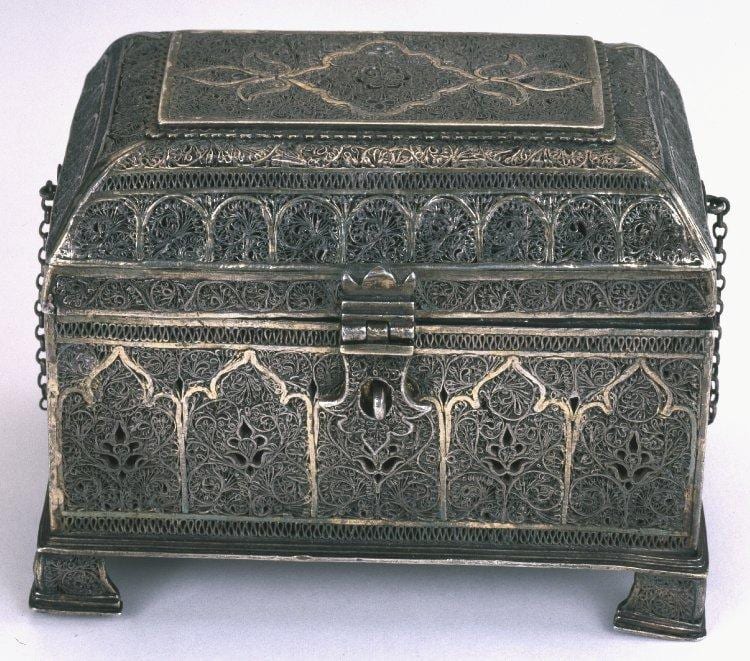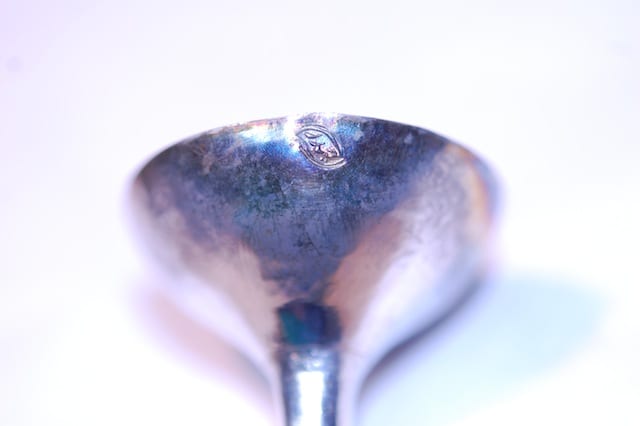The casket, which measures 13cm long, 9cm high and 8.5cm deep, is made entirely of fine, openwork silver and silver gilt filigree. The filigree consists of scrolling foliage, which on the sides of the casket is contained in repeated arched panels around a central stylised flower, highlighted by the use of flattened, gilded wire. The scrolling foliage continues across the hinged bevelled lid in smaller panels and bands. On the top of the lid is a central six-petal flower surrounded by a scalloped diamond in gilded, flattened wire which develops into a trefoil design. This design is mirrored on the base of the casket. The casket is raised up on four feet and would have been closed using the loop and palmette-shaped hinged lock, although almost no evidence is visible (wear or scratching) on the casket, which suggests it was not repeatedly locked shut. Both the feet and the hinged lock are decorated with scrolling foliage.
Inside the casket is an inserted panel with eight circular holes which separate and hold six silver bottles. Two smaller holes in the panel hold the silver funnel and ladle which accompany the bottles. The bottles, ladle and funnel are all made of highly polished silver, whilst the inserted panel is decorated with the same scrolling foliage seen on the exterior of the casket, indicating that the interior insert was made at the same time as the casket and was not a later addition.
Most likely made in the eighteenth century, the casket is a combination of both European and Indian motifs and designs. The shape of the casket is typical of European filigree and silver work and is also seen in Mughal and Persian examples, whilst the scrolling decoration is common to Indian-made articles of this type. During the eighteenth century, with the growing engagement between the East and the West, artistic exchanges increasingly took place, not just in metal work but also painting, sculpture and architecture. Filigree production flourished in various centres in the Indian subcontinent during the eighteenth century, including cities such as Goa and Karimnagar in the Deccan. Susan Stronge suggests that the casket possibly comes from the Deccan, although the shape bears a strong resemblance to boxes and caskets known to have been produced in Goa and the decorative motif of the scrolling foliage is also found on filigree examples produced in southern and eastern India.[1]
The use of silver filigree throughout the construction of the casket, including the base, which in other examples was more commonly made of solid silver sheets, makes the casket lightweight and easy to handle and transport. Caskets such as these are often referred to as ‘attardans’ or scent holders, and would have been used to store perfumed oils and water. This then explains the presence of the funnel and the ladle which would have been used to decant liquids into and out of the silver bottles. Perfumed oils and waters, such as rose water were typically used during festivals, dinners and social events to create a luxurious and fragrant atmosphere as well as having a more intimate use such as perfuming the body and clothes. The intended use of the casket as a holder of perfumed liquids, used mainly by the elite, and the inclusion of a hinged lock, indicates that the casket was most likely regarded as a luxury item both within the court of Mysore and European society.
We know from the documents which accompany the casket that Henry Fraser identified a minute stamp on the silver funnel, translating the Persian inscription as ‘Hyder’ which he read as a reference to Hyder ‘Ali, Tipu Sultan’s father, reinforcing the Frasers’ belief in the connection between the casket and the family of Tipu Sultan. Interestingly a reappraisal of the inscription has highlighted that what Fraser read as ‘Hyder’ can also be translated as ‘Haider’ or more importantly ‘Haydar’.[2] Haydar can be both a personal name, meaning lion, or as Stronge states, ‘Haydar’ is the title given to the Prophet’s son-in-law ‘Ali (the first Shi’ite Imam).[3] Stronge argues that in instances where ‘Haydar’ (حيدر) or an ‘H’ (ﺡ) are written, stamped or inlaid onto items from Tipu Sultan’s court, Tipu was referring to Haydar the Prophet’s son-in-law rather than his father.[4] The ‘Haydar’ is surrounded by a bubri or babri pattern, a stylised tiger stripe which appeared on numerous objects associated with Tipu, including guns, textiles, swords, painting and architectural decoration[5].
The tiger became so closely associated with Tipu Sultan that he was and still is often referred to as the ‘Tiger of Mysore’. This use of the tiger as a symbol was not just a reference to the Islamic and Iranian belief in the tiger and lion being interchangeable symbols of power and religion, but also reflected Hindu traditions in which Shiva is often shown seated on or wearing a tiger skin in reference to his ascetic nature. Although Tipu Sultan and Hyder ‘Ali were both Muslims, the kingdom which they ruled was predominantly Hindu and the use of the tiger, an animal and motif connected to one of the most well-known and popular Hindu deities, may have produced a positive association with the local populace towards these new rulers. In this regard, the use of ‘Haydar’ within the tiger stripe produced multiple allusions and associations on both a local and global level. These varied meanings not only allied Tipu Sultan and his kingdom to the local population and so helped to maintain a stable populace, but also demonstrated Tipu’s religious devotion. This is also mirrored somewhat in the ‘Haydar’ stamp: when translated by Henry Fraser, he took it to mean ‘Hyder ‘Ali’ and so confirmed devotion to a family dynasty, not only for the Fraser family in their acquisition of the object but also as suggested by Tipu’s inheritance of the casket from his father. Although Henry Fraser most probably missed the religious association of the stamp which Stronge argues was its genuine meaning, the fact that he was researching and studying this casket shows an attempt to understand the object in his possession, not just as a decorative item but also its history and the inference of its inscription.
Return to case study menu / Next
[1] Susan Stronge, Tipu’s Tigers (London: V&A Publishing, 2009), p. 50, fig 50.
[2] The authors are grateful to Dr. Vesta Curtis and Paramdip Khera, Coins and Medals department, British Museum, for assisting in the reviewing of the stamp’s translation.
[3] ‘Imam’ is a title used for Islamic religious leaders and most commonly refers to those who lead prayers in mosques. ‘Ali was the cousin and son-in-law of the Prophet Muhammad. Shi’ites, members of the Shi’a branch of Islam, believe that ‘Ali was the first Imam of Islam and the heir of Muhammad.
[4] Stronge, Tipu’s Tigers, p. 36.
[5] Another example of this stamp being used on items from Tipu’s court can be foiund in a jewelled Navratna pendant which went to auction at Bonhams on the 28th September 2011. http://www.bonhams.com/auctions/19576/lot/163N/ Accessed 13 May 2013.


